A Study on the Vertical Bearing Characteristics of Screw Piles in Permafrost Regions
Abstract
1. Introduction
2. Model Test
2.1. Design of Experiment
2.2. Test Results and Analysis
2.3. Comparison Between Numerical Simulation and Laboratory Test
3. Numerical Simulation Analysis
3.1. Calculation Model and Model Parameters
3.2. Analysis of Calculation Results
3.3. Comparison and Analysis of Screw Pile and Ordinary Pile
4. Vertical Bearing Capacity Calculation Method
5. Conclusions
- (1)
- Approximately 90% of the bearing capacity of screw piles in permafrost regions results from the mechanical bonding between pile side’s concrete and the permafrost soil. The seasonally active layer has a minimal impact on the pile’s bearing capacity, and the bearing capacity of the pile’s body is stable throughout the year.
- (2)
- The equivalent friction resistance of screw piles is far greater than that of conventional cast-in-place piles when used in permafrost regions. The screw pile and the soil occlude each other, resulting in a higher equivalent friction resistance of the pile’s side at the beginning and the end of the thread than that of the conventional pile type, which is significantly different from the conventional pile type.
- (3)
- When the pile reaches the ultimate bearing capacity, the plastic zone of the pile’s side is connected, and the soil around the pile is undergoing shear. Using the improved formula to calculate the vertical bearing capacity of a single pile provides a conservative and practical estimate of the design value of the bearing capacity of a single pile in engineering practice.
Author Contributions
Funding
Institutional Review Board Statement
Informed Consent Statement
Data Availability Statement
Conflicts of Interest
References
- Chen, K.; Yu, Q.; Guo, L.; Luo, X.; Chen, J. Analysis of pile-soil heat transfer process based on field test in permafrost regions. Chin. J. Rock Mech. Eng. 2020, 39, 1483–1492. [Google Scholar]
- Chen, K.; Yu, Q.; Guo, L.; Guo, L.; Wen, Z. Artificial cooling of cast-in-place piles in permafrost regions. China J. Highw. Transp. 2020, 33, 104–114. [Google Scholar]
- Yu, Q.H.; Zhang, Z.Q.; Wang, G.S.; Guo, L.; Wang, X.; Wang, P.; Bao, Z. Analysis of tower foundation stability along the Qinghai-Tibet Power Transmission Line and impact of the route on the permafrost. Cold Reg. Sci. Technol. 2016, 121, 205–213. [Google Scholar] [CrossRef]
- Lukpanov, R.E.; Yenkebayev, S.B.; Tsigulyov, D.V. Assessment of the bearing capacity of piles in soil, determined by static and dynamic load tests. Eng. J. Satbayev Univ. 2021, 143, 252–260. [Google Scholar] [CrossRef]
- Tiutkin, O.; Radkevych, A.; Dubinchyk, O.; Kharchenko, V. Parametric analysis of a strain state of a soil base strengthened with vertical elements. Min. Miner. Depos. 2024, 18, 104–112. [Google Scholar] [CrossRef]
- Polishchuk, A.I.; Maksimov, F.A. Improving the Design of Screw Piles for Temporary Building Foundations. Soil Eng. Found. 2016, 53, 282–285. [Google Scholar] [CrossRef]
- Malik, A.A.; Kuwano, J.; Tachibana, S.; Maejima, T. End bearing capacity comparison of screw pile with straight pipe pile under similar ground conditions. Acta Geotech. 2017, 12, 415–428. [Google Scholar] [CrossRef]
- Li, C.; Chen, J.; Wu, Q.; Xia, X.H.; Wang, J.H. Bearing mechanism and calculation method of screw pile. J. Shanghai JiaoTong Univ. 2010, 44, 726–730. [Google Scholar]
- Qian, J.; Chen, H.; Jia, P.; Huang, M.S.; Hu, Y.Y. Experimental study of mechanical behaviours of grouting-screw pile interface. Chin. J. Rock Mech. Eng. 2013, 32, 1744–1749. [Google Scholar]
- Zhou, Y.; Xiao, S.; Xu, J.; Hu, Y.Y. Model test on vertical bearing capacity of variable cross-section thread piles. Rock Soil Mech. 2017, 38, 747–754. [Google Scholar]
- Ma, W.; Wang, D. Mechanics of Frozen Soil; Science Press: Beijing, China, 2014. [Google Scholar]
- Xu, X.; Wang, J.; Zhang, L. Frozen Soil Physics; Science Press: Beijing, China, 2010; pp. 82–90. [Google Scholar]
- Mahedi, M.; Satvati, S.; Cetin, B.; Daniels, J.L. Chemically induced water repellency and the freeze-thaw durability of soils. J. Cold Reg. Eng. 2020, 34, 04020017. [Google Scholar] [CrossRef]
- Wu, Y.P.; Wang, H.; Wang, N. Experimental method of ultimate bearing capacity of pile foundation in permafrost region. China J. Highw. Transp. 2018, 31, 38–45. [Google Scholar]
- Guo, C.; Wu, Y. Effects of solar radiation and global warming on bearing capacity of single pile in permafrost region. Chin. J. Rock Mech. Eng. 2014, 33 (Suppl. 1), 3306–3311. [Google Scholar]
- Wu, Y.; Su, Q.; Guo, C.; Zhu, Y.L.; Zhang, L.X.; Zhao, S.Y. Nonlinear Analysis of ground refreezing processfor pile group bridge foundation in permafrost. China Civ. Eng. J. 2006, 39, 78–84. [Google Scholar]
- Wu, Y.; Guo, C.; Pan, W.; Zhao, S.Y.; Zhang, L.X. Influences of refreezing process of ground on bearing capacity of single pile and bridge construction in permafrost. Chin. J. Rock Mech. Eng. 2004, 23, 4229–4233. [Google Scholar]
- Wang, X.; Jiang, D.; Liu, D.; He, F. Experimental study of bearing characteristics of large-diameter cast-in-place bored pile under non-refreezing condition in low-temperature permafrost ground. Chin. J. Rock Mech. Eng. 2013, 32, 1807–1812. [Google Scholar]
- Wang, X.; Jiang, D.; Zhao, X.; Shi, C.S.; Wang, C.H. An experimental study on refreezing characteristics of large-diameter bored pile in different permafrost areas of the Qinghai-Tibet plateau. Chin. J. Rock Mech. Eng. 2004, 23, 4206–4211. [Google Scholar]
- JGJ 106-2003; Ministry of Construction of the People’s Republic of China. Technical Code for Testing of Building Foundation Piles. China Architecture & Building Press: Beijing, China, 2004.
- Xu, L. Study on the Test and the Load-Bearing Characteristics of Half-Screw Pile. Master’s Thesis, Hefei University of Technology, Hefei, China, 2013. [Google Scholar]
- JGJ 118-2011; Ministry of Housing and Urban-Rural Development of the People’s Republic of China. Code for Design of Soil and Foundation of Buildings in Frozen Soil Region; China Architecture & Building Press: Beijing, China, 2012.

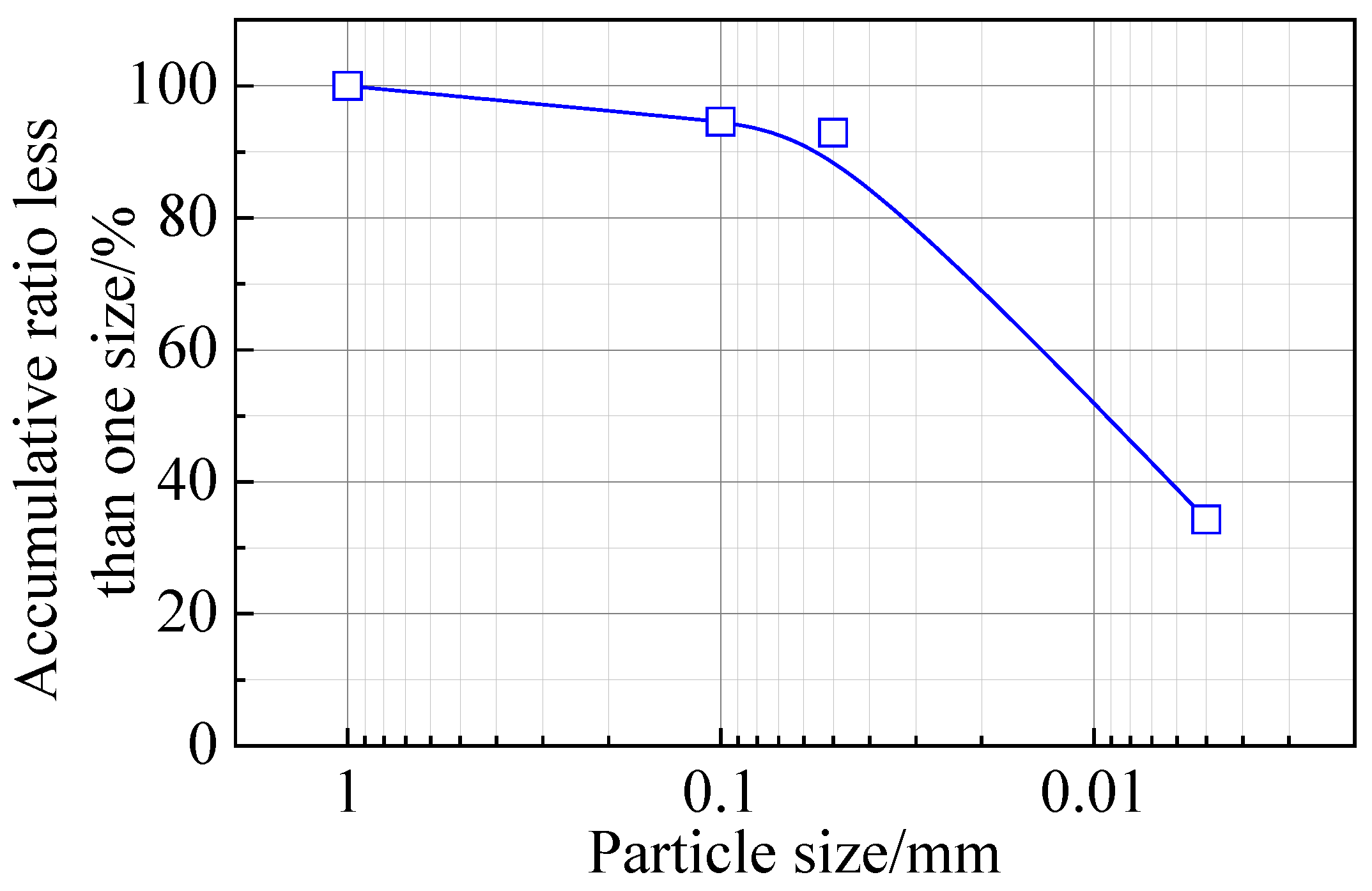
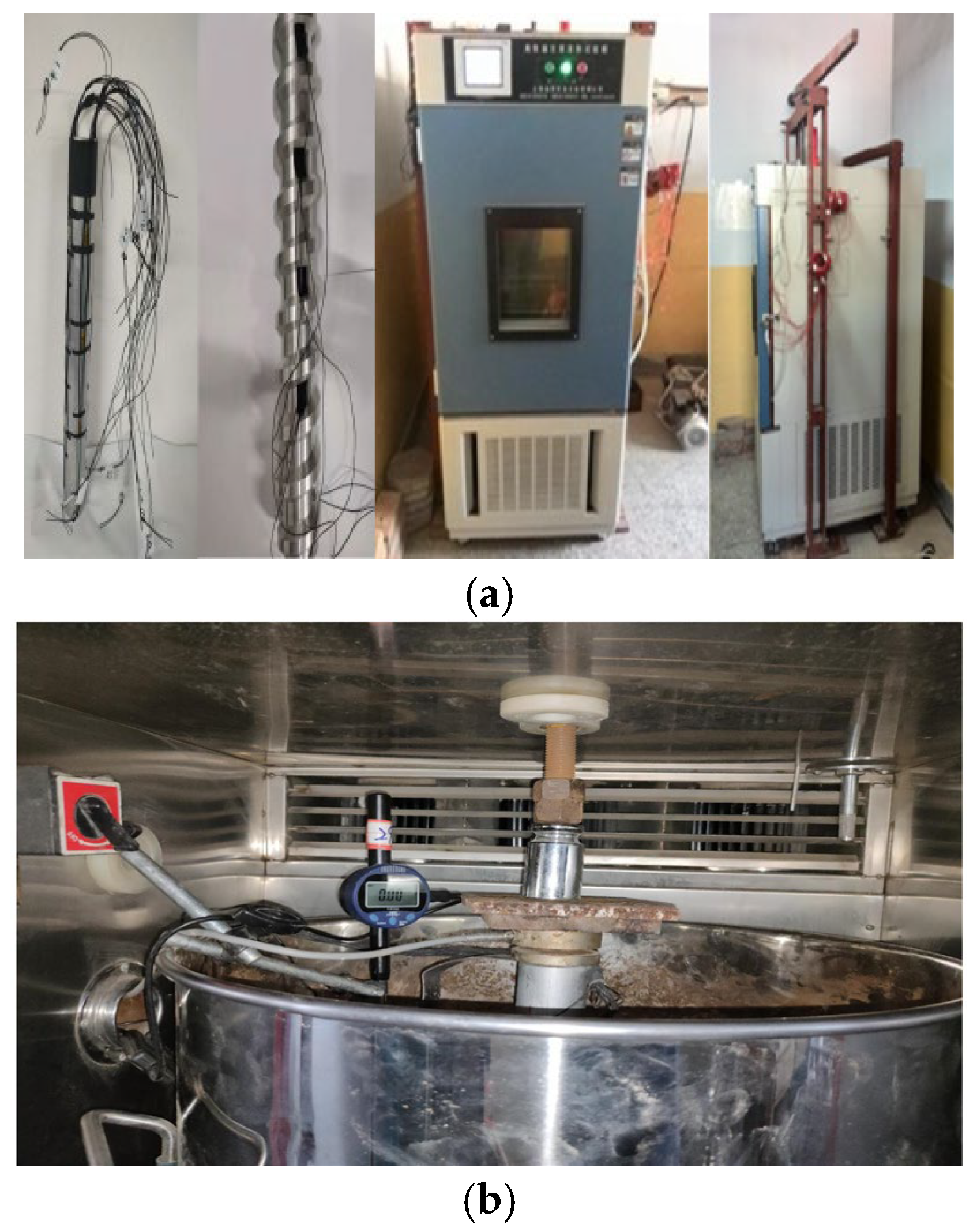
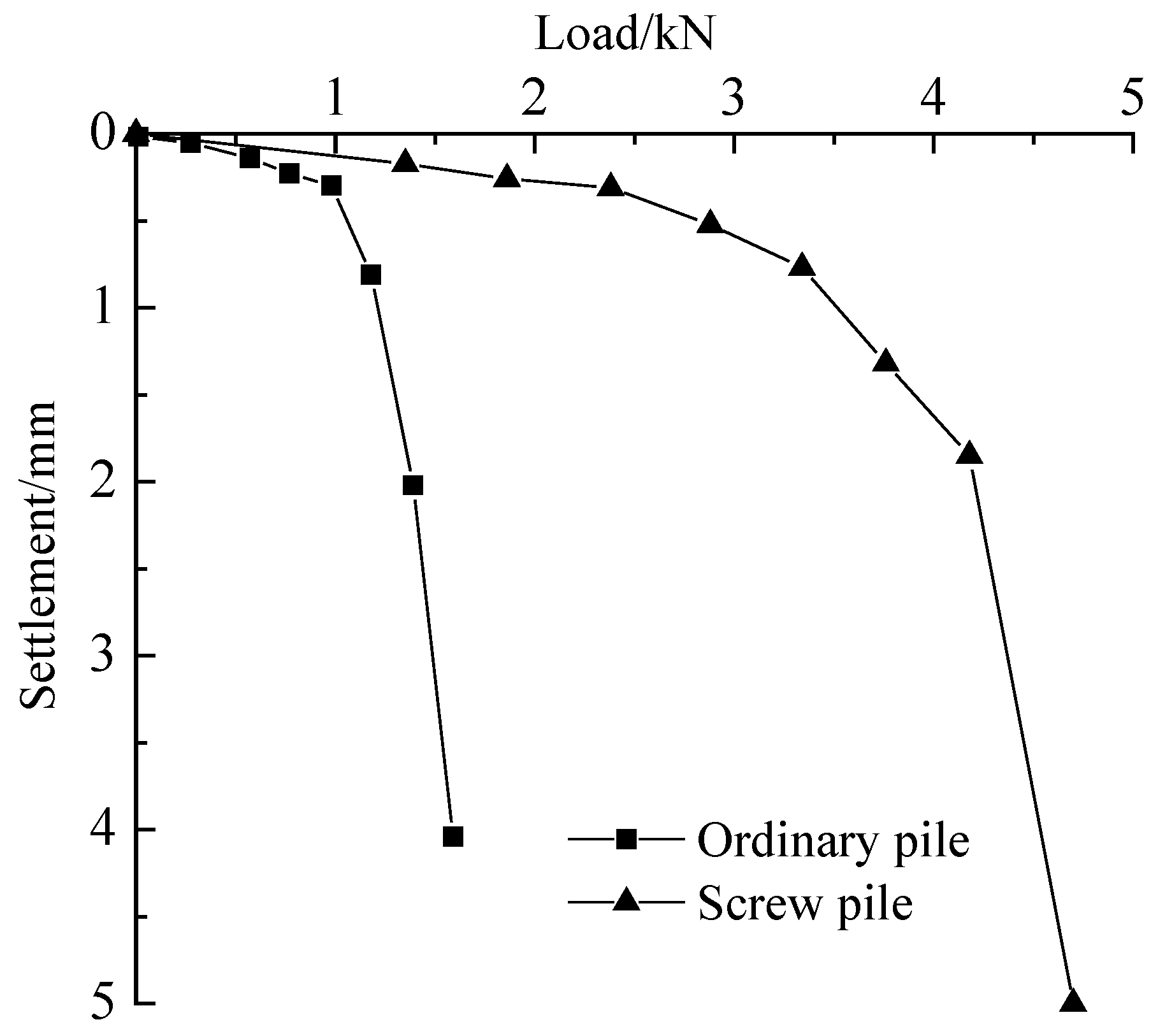




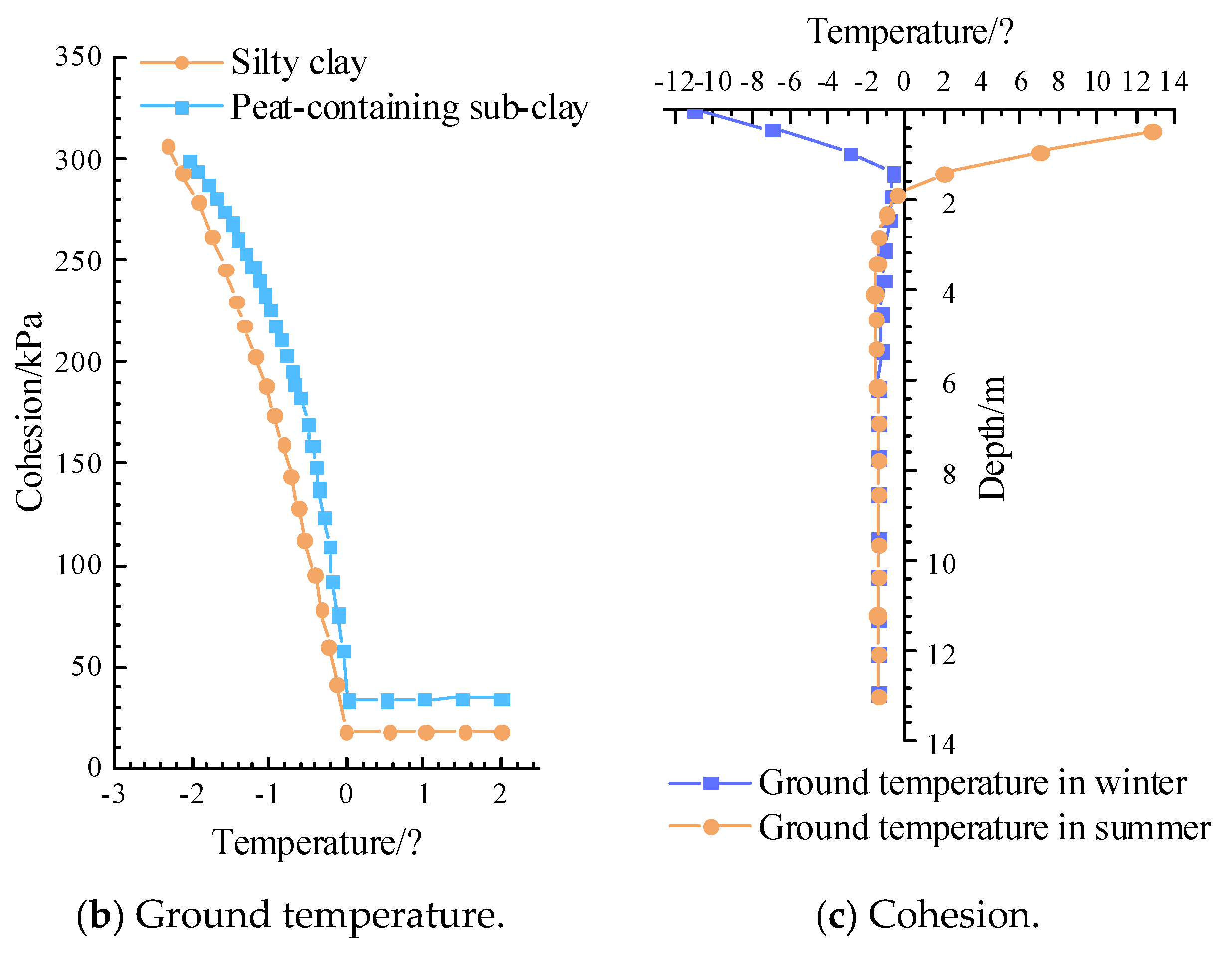
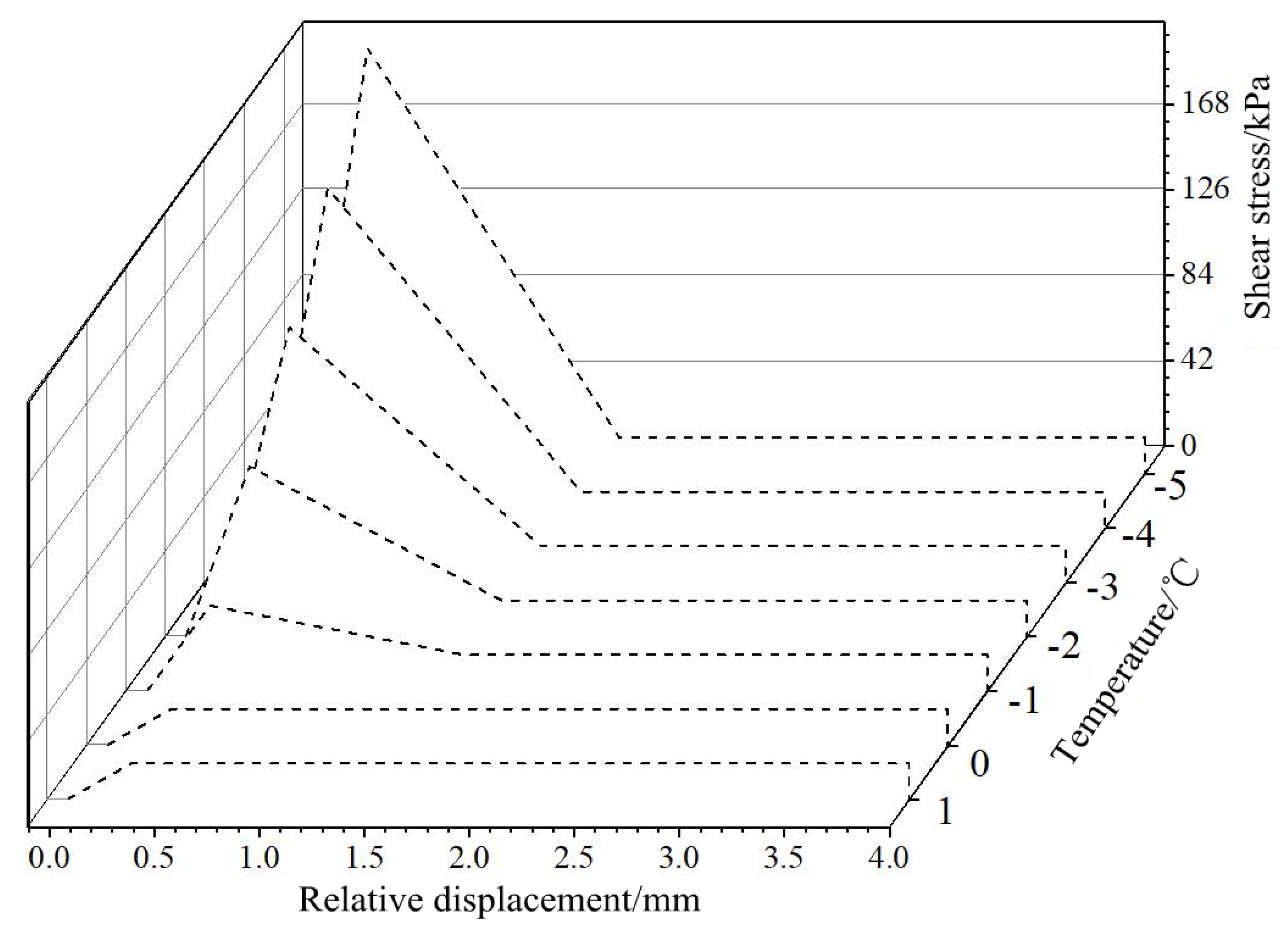
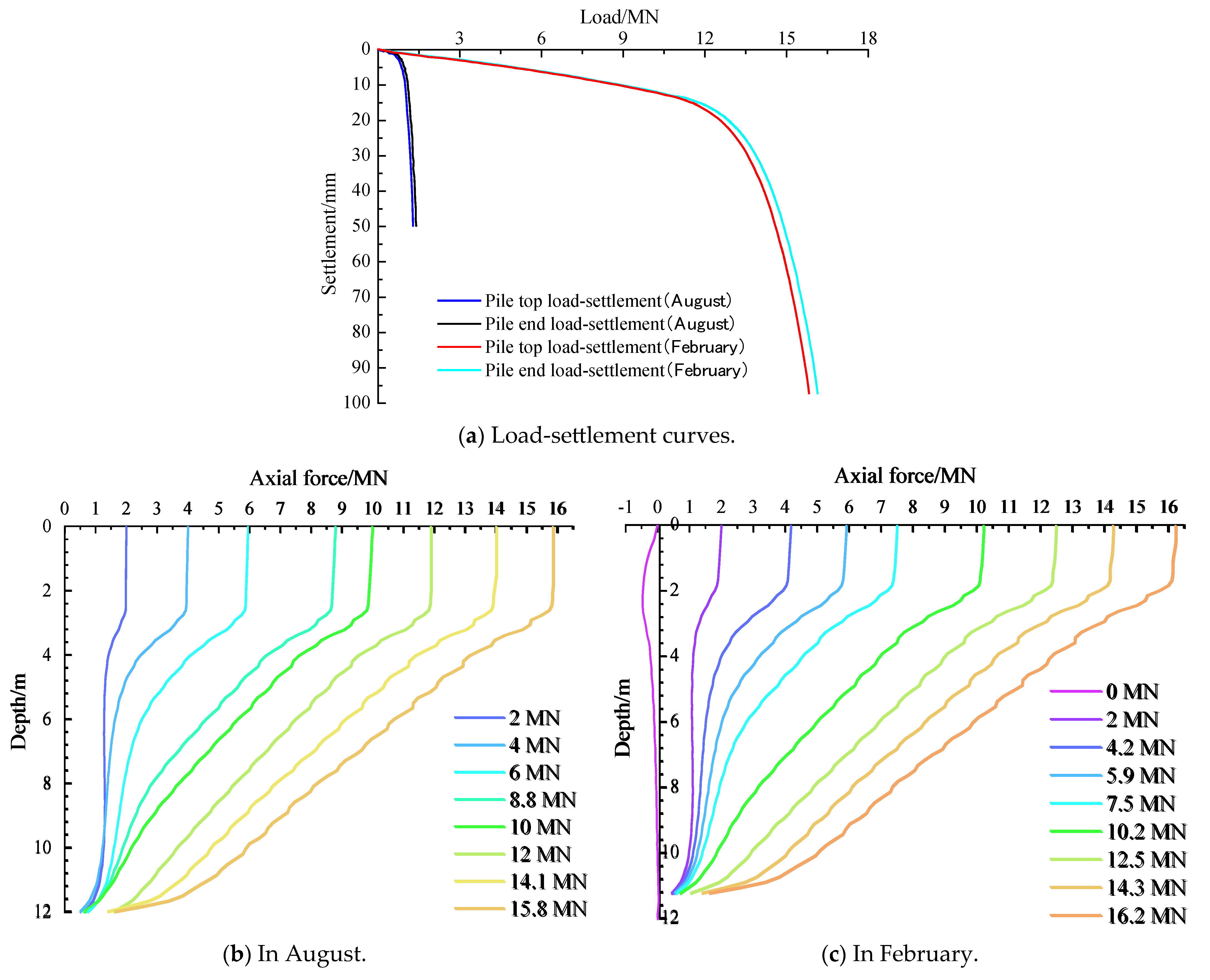
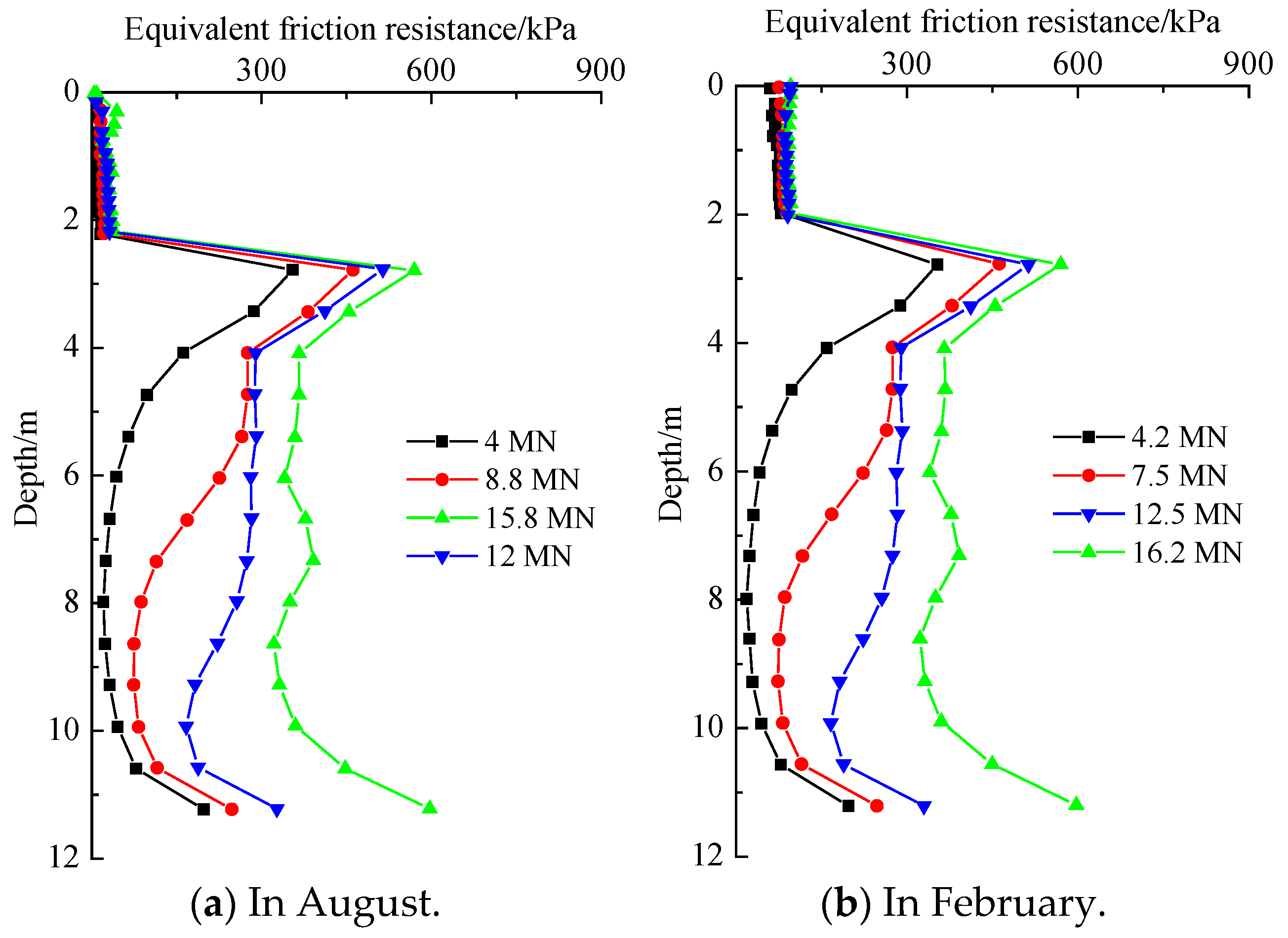

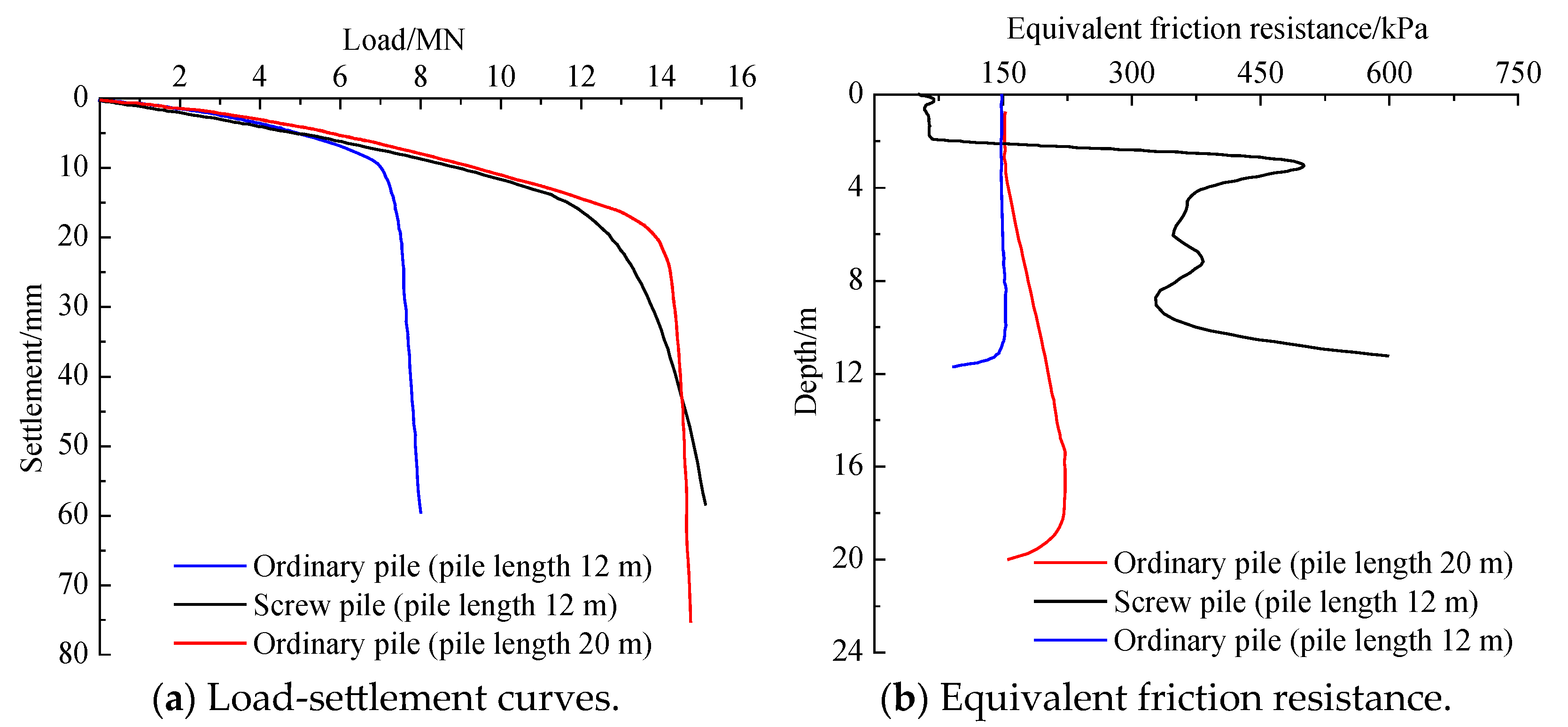
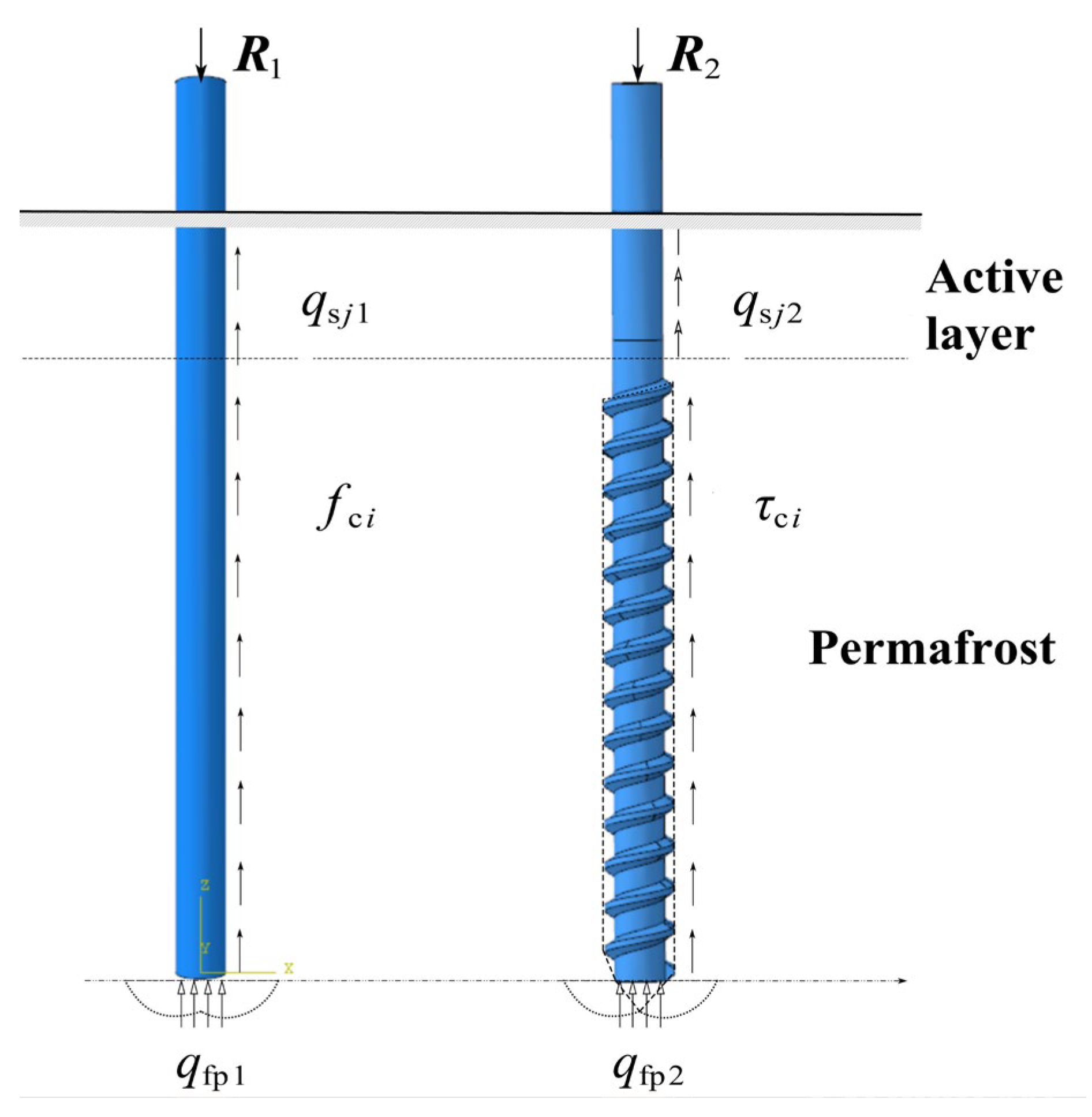
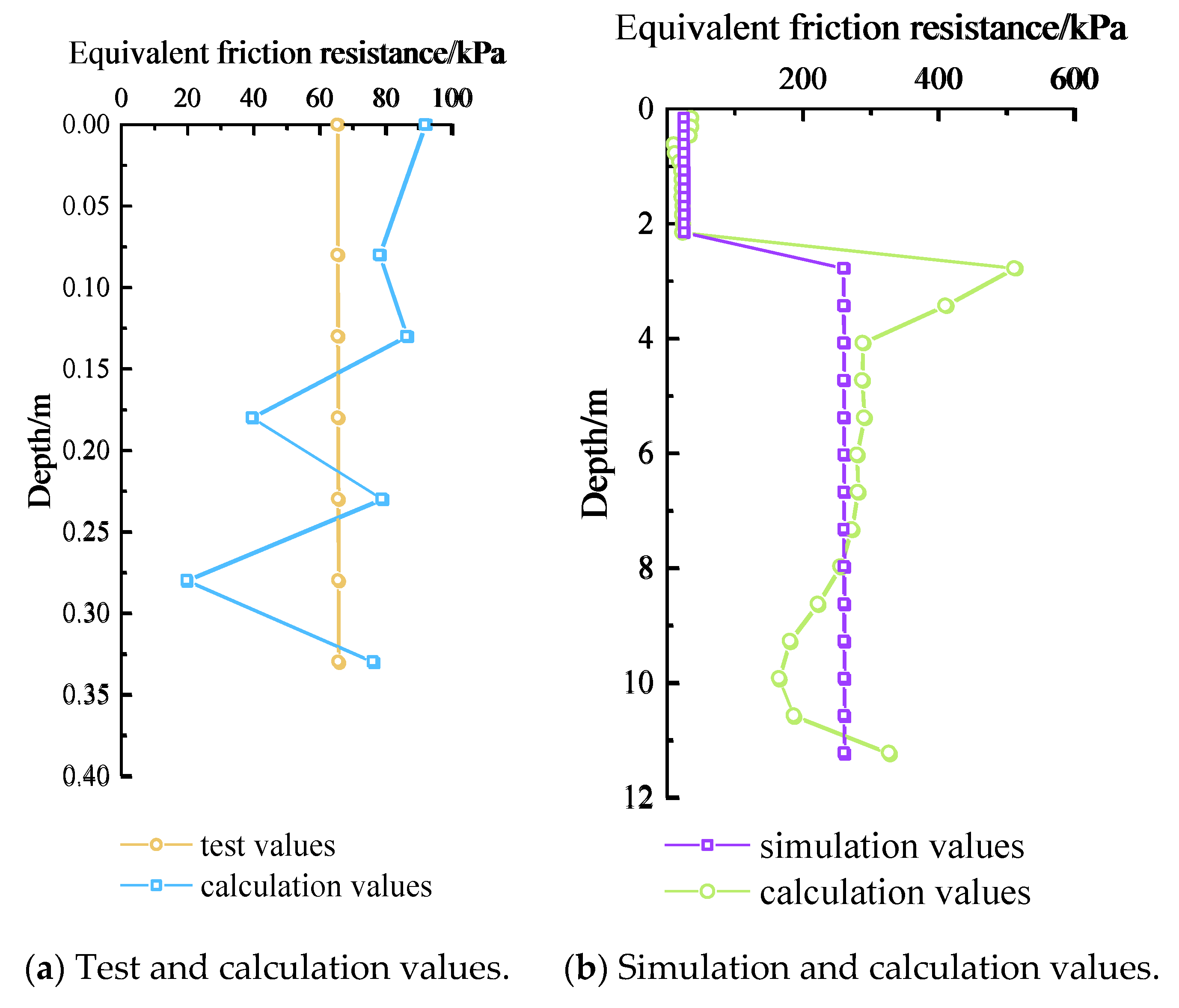
| Materials | Modulus of Elasticity/MPa | Poisson Ratio | Cohesion/kPa | Angle of Internal Friction/° | Soil Weight/ (kN·m−3) |
|---|---|---|---|---|---|
| soil | 340 | 0.40 | 65.4 | 0.8 | 19 |
| pile | 72,000 | 0.33 | 22 |
Disclaimer/Publisher’s Note: The statements, opinions and data contained in all publications are solely those of the individual author(s) and contributor(s) and not of MDPI and/or the editor(s). MDPI and/or the editor(s) disclaim responsibility for any injury to people or property resulting from any ideas, methods, instructions or products referred to in the content. |
© 2025 by the authors. Licensee MDPI, Basel, Switzerland. This article is an open access article distributed under the terms and conditions of the Creative Commons Attribution (CC BY) license (https://creativecommons.org/licenses/by/4.0/).
Share and Cite
Liu, T.; Lv, J.; Deng, X.; Guo, C.; Zhang, W.; Jiang, D. A Study on the Vertical Bearing Characteristics of Screw Piles in Permafrost Regions. Appl. Sci. 2025, 15, 7416. https://doi.org/10.3390/app15137416
Liu T, Lv J, Deng X, Guo C, Zhang W, Jiang D. A Study on the Vertical Bearing Characteristics of Screw Piles in Permafrost Regions. Applied Sciences. 2025; 15(13):7416. https://doi.org/10.3390/app15137416
Chicago/Turabian StyleLiu, Tao, Jun Lv, Xuyan Deng, Chunxiang Guo, Weijia Zhang, and Daijun Jiang. 2025. "A Study on the Vertical Bearing Characteristics of Screw Piles in Permafrost Regions" Applied Sciences 15, no. 13: 7416. https://doi.org/10.3390/app15137416
APA StyleLiu, T., Lv, J., Deng, X., Guo, C., Zhang, W., & Jiang, D. (2025). A Study on the Vertical Bearing Characteristics of Screw Piles in Permafrost Regions. Applied Sciences, 15(13), 7416. https://doi.org/10.3390/app15137416





